The recipe they follow is from a book written by Keiko Ishida, Okashi (sweet treats made with love. As I am writing from a 3rd party point-of-view, I will just give a pictorial of the steps involved.
Ingredients needed:
5 Egg Yolks
20g Fine Sugar
60g Water
60g Canola Oil
1 tsp Vanilla Essence
80g Cake Flour
For the meringue,
110g Fine Sugar
10g Corn flour
5 Egg Whites
Steps:
1. Preheat oven to 160°C
2. Sift flour twice
3. Mix egg yolks and sugar (20g)
4. Add water, canola oil, vanilla essence and continute mixing
5. Add sifted flour and mix well to achieve a sticky and smooth batter
6. Combine corn flour and sugar (110g)
7. In another bowl, whisk the egg whites till it is foamy
8. Add half the sugar-cornflour mixture and continue beating for a few mintues.
9. Add the remaining sugar-cornflour mixture and beat until stiff and shiny peak
10. Add one-third of the meringue into egg yolk mixture and fold in lightly
11. Add the remaining meringue and continue folding
12. Pour in the batter into an ungreased chiffon tube pan
13. Bake for 40min to 50 min
14. Turn it over, allowing it to cool
15. Use a spatula or knife to loosen the cake before inverting onto a cooling rack
Some things to note:
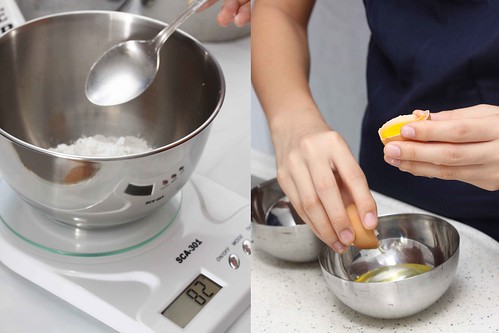
Note:
All recipes refers to large eggs (minimally 60gm)
Eggs must be at room temperature, so equilibrate the eggs for about 30 min before starting baking.
Possible error:
While separating eggs, ensure the bowls are free from water, oil, egg yolks and any possible contaminants. Egg whites are very petty ingredients. In fact, after all the mistakes, daddy decides to have separate metallic bowls for the eggs.
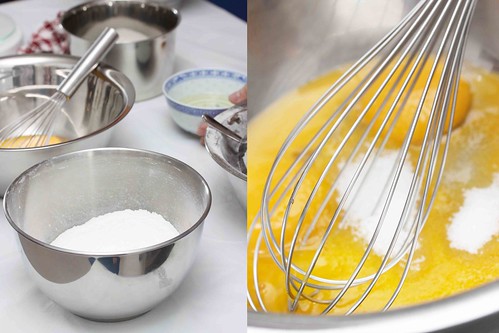
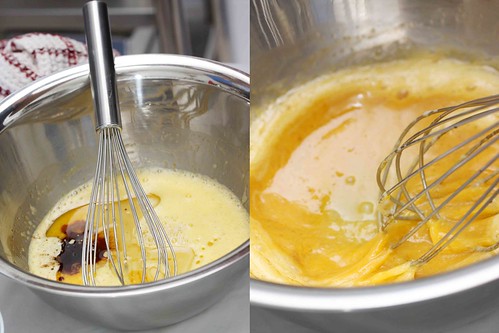
Note:
Oil, water, egg yolk and flour must be well blended in order to build up the gluten structure. This allows the cake to be "bouncy".
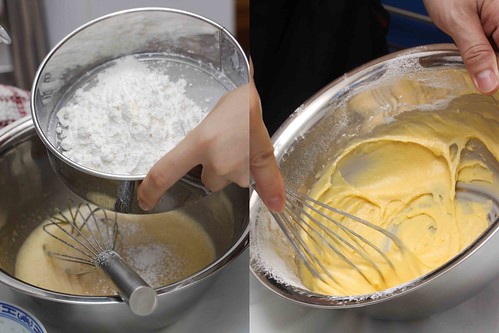
Note:
Cake flour is made of soft wheat and contain less than 9% protein (lowest in protein); hence is suitable for making soft and light-textured cakes.
Possible error:
Daddy used to assume that plain flour and cake flour are the same but alas, they give very different texture.

Note:
Sugar and corn flour are mixed before adding to the egg white.
Possible error:
Corn flour tends to clump, the moment these clumps end up in the whites, these clumps will stay in the cake batter.
When making a meringue, it is important not to add sugar to the egg whites. This will take a long time to whip as egg whites will become very heavy. Whip egg whites first to create some volume before adding sugar.
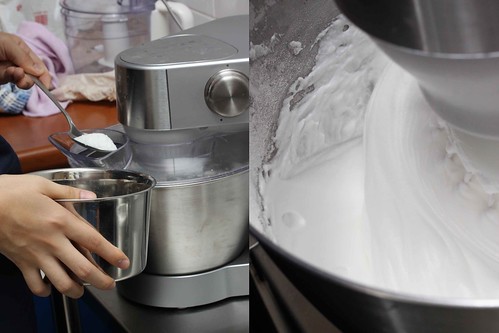
Note:
Once the egg whites have some volume, add the sugar little at a time.
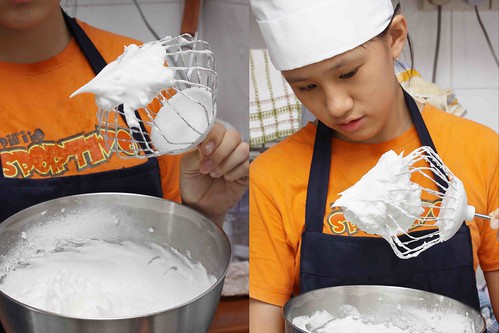
Note:
To check the meringue, dip the whisk into the mixture, twist it and point it 90°. As shown in the picture on the left, when the peak droops, it is a soft peak. Any further whisking will lead to a stiff peak (as shown on the right).
Possible error:
Overwhisking of egg whites will make the meringue lose its shine or attain a curd-like texture. It takes less than a minute to get a stiff peak from a soft peak.

Note:
For easy mixing, adding only one-third of the meringue in the beginning is essential (mixing is made tricky as the meringue and the egg yolk mixture have different densities).
Folding is done in alternating steps of folding (and turning the bowl at the same time) and chopping action.
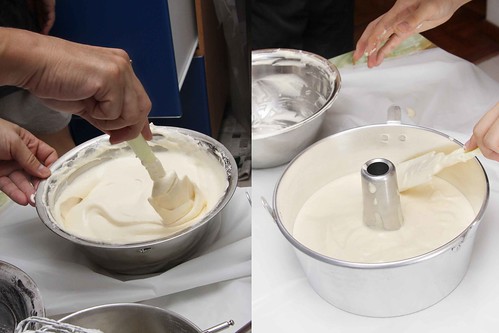
Note:
Make shallow slits on the top crust just before baking and make some after the crust is formed. The small slits enable the inner mositure to evaporate and to bake the centre of the sponge (Do the second sets of silts quick as oven temperature will fluctuate).
Possible error:
Do not grease the pan and a chiffon cake pan or tube pan is a must.
Size of the pan is important, 22-cm pan is big for this recipe.

Note:
Baked chiffon cake must be turned over for cooling. Failure to do so will result in sinking of the cake.
Possible error:
Underbaking results in insufficient cringing of the cake to the tin, causing the cake to drop onto the cooling rack. This cause the cake to sink.

Personally, I prefer an underbaked chiffon as it is more moist and surprisingly it has a similar texture like Glace's tofu chiffon, denser but retains its softness and moistness. Previously, daddy has tried 45min and 50min but the cake fails to cling. This was delibrately baked for 55min so that it will cling onto the tin. Though soft, it is alittle dry to my liking.
We didn't slice off the top crust so Yuan feels that it tasted like kuih bahulu. A little dry with slight burnt on the other layers.

13 comments:
Wow great job! Your chiffon looks great. Photos are fab.
Thanks for sharing fen. The chiffon looks really well made, I'm sure it tastes good too. You don't need anymore to eat chiffon from anywhere else, your kitchen does best. (:
thanks for the step by step tutorial! it's uncommon to see recipes which provide close guidance (:
You could try using more exotic ingredients like Japanese flour or white eggs or others found in specialty supermarkets, because local ingredients are usually inferior in quality. And also take note that room temperature can mean differently in different countries. It is usually 25 deg C. If you really want to be more precise, you should mix the ingredients in an air-conditioned room. Simply put, if you want 'foreign taste', you should avoid local temp and ingredients.
Here are some more of my comments--
The cake has a thick crust and small pores because cream of tartar was not used, so the cake mixture is more dense. And I think you did not use parchment paper to line the bottom of the tube pan. You could try baking in a smaller pan so that it would be less dry and more fluffy.
I have seen that cookbook before and since it is based on natural ingredients, it would create dense results.
Convection oven results in more fluffy cakes than convention ovens. And I think the recipe's temp refers to convection oven because if it was meant for convention oven, the temp would have to be decreased 20 deg less for convection but 140 deg is too low to bake a cake.
It is quite complicated to bake a cake but the experimentation is the fun part.
PY: Thank you for your compliment.
Ice: The chiffon is on the dry side, will attempt with a smaller pan. =)
This is only vanilla chiffon cake, I need to go to Bengawan for my pandan chiffon fix >.<
Stargirl: Thanks, that is because I don't bake very often so the safest bet is to take a picture of every single step. Hope it will be useful.
Taster: When you mention about Japanese flour, is it the same as cake flour?
I do agree with you with better ingredients but I am still in the experimenting phase, have to get it right before I invest in better ingredients. As for foreign taste, this is still very subjective. For instance, despite refering to books and internet website, I still do not have a clear definition of genoise sponge. Some claims to be baked in a similar manner as a regular sponge while others mentions the use of the water bath. For that, I doubt I am in any position to comment about foreign taste, particularly when I have not tasted cakes from other countries nor have sufficient baking knowledge.
Back to the chiffon topic, when you mention cream of tartar, I presume this is added to the egg whites, am I right? Now I have a question, what is the difference between baking soda, bicarbonate and cream of tartar? Shouldn't the former be better since they produce carbon dioxide?
Oh, as for parchment paper, I thought we are not supposed to line the chiffon pan so that the cake can cling during cooling? Will it drop if the parchment paper is placed beneath?
Yea, daddy prefers this book as the steps are very clear and like you point out, most recipes do not use emusifiers and leavening agents.
Experimentation is fun but the thought of eating the same thing for the entire week is no joke.
The Japanese flour I mentioned is flour made in Japan and is available in different types for cooking. You can find it at Meidi-ya. Food grown in Japan are grown on fertile volcanic soil and are very wholesome in quality. They are stronger in taste and have more resilent texture. You can use better quality ingredients like this to make your baking attempts less susceptible to failure.
l'm also not clear about the traditional genoise sponge since I'm not interested in cakes with that kind of sponge.
Cream of Tartar is meant to cause the beaten egg whites to be more stable or firm volume. More volume means it can handle more heat. If you leave this out, the cake batter will have less volume and will be dense so it can get burnt easier and faster.
Baking soda alone creates large gas bubbles. It is used with an acidic ingredient like cocoa powder or vinegar.
Baking powder is made of baking soda with an acidic component and starch. It creates fine gas bubbles for light textures like cakes.
If you have a good sturdy recipe, the chiffon cake should be able to cling during cooling even if you use parchment paper. Many bakers use it without problems.
Even with the same recipe and correct weight of the individual ingredients, different quality can create different results. So this is where experience comes in to recognize and create the right consistency or 'feel' of the batter.
Ok, maybe I will drop by Meidi-ya to have alook. Thank you for the suggestion.
Seems like the addition of Cream of Tartar allow the cakes to take more abuses. Will keep that in mind.
One last question, some of the chiffon recipes uses extra egg whites. For this recipe, it uses equal amount of yolks and whites, does the additional egg whites make alot of difference?
Some of the recipes adopt extra 2 whites while some uses purely egg whites.
Thinking of experimenting other recipes but the thought of having extra yolks hold me back. Had alot of wastage while making macarons.
Japanese brands from local supermarkets is the convenient choice if you can't find other more exotic brands like King Arthur's flour.
The egg yolk is a stabilizer and has strong flavor. The egg white creates fluffiness. It is up to individuals to vary the amount of each in their own recipes.
I said that even with correct weight of ingredients, different types and quality of ingredients will create different results, so it is still up to one to adjust the recipe to one's own preference. Saying this, I don't understand why people have to come up with very specific weights in their recipes like for example, 154g instead of just rounding off to 150g. They do not have the experience yet to realize there is always a constant need to adjust the weight of ingredients based on different brands and qualities. So recipes that call for specific weights are most probably made by amateurs who lack knowledge in discerning different qualities of ingredients and may not be as foolproof as you may think they are. It all comes down to trial and error in the end.
Ah, that makes things alot easier when you state the brand. Alright, will keep alook out and use it in my next attempt.
Lately, I came across a recipe that uses solely egg whites with milk and the texture described is similar to white bread. That kinda stir my curiousity since I adore Arinco King's cake sponge.
By far, the only recipe I come across that uses weight measurement is macaron shells. As I have only experimented several times, the ingredients used are pretty much from the same source but to be frank, taste-wise, the recipe is quite accurate on my first try.
Even for eggs, size does matter. Daddy start off with small eggs (i.e. 55gm) and also the extra large ones (i.e. 70gm), the results obtained are quite contrasting. (My personal take) For a start, weight can give first-timers a rough head start and from there, it is easier to adjust the taste or texture. Can be depressing when a recipe failed and there is nothing to eat after all the effort.
Yes, the weight of little key portions of ingredients do matter such as the measuring of sensitive wet binding ingredients, or baking powder that go by the little spoons.
But to try to be too precise for dry ingredients like flour or butter for a huge portion over 100g or 200g is quite obsessive.
I understand what you meant. In fact, we have a habit of topping certain dry ingredients to ensure the batter is of the correct consistency.
Tried another recipe of chiffon that uses 2 extra egg whites. The chiffon is alot lighter. I will try to add cream of tartar on my next attempt. Since it is not stated in the second recipe, what is the approximate / recommended usage of cream of tartar for each egg white?
I'm so amazing at what I saw on your blog,was searching for a nice site where I can get Vanilla Chiffon Cake for my cousin's birthday. Your Vanilla Chiffon Cake looks attractive and adorable .
I will like to you to bake a cake for my cousin's birthday that is coming up next month
Post a Comment